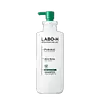What's inside
What's inside
 Key Ingredients
Key Ingredients

 Benefits
Benefits

 Concerns
Concerns

 Ingredients Side-by-side
Ingredients Side-by-side

Water
Skin ConditioningSodium Cocoyl Isethionate
CleansingDisodium Laureth Sulfosuccinate
CleansingLauryl Betaine
CleansingGlyceryl Stearate
EmollientTrihydroxystearin
Skin ConditioningPolyquaternium-10
Caffeine
Skin ConditioningCetyl Alcohol
EmollientDicaprylyl Ether
EmollientSodium Benzoate
MaskingSodium Salicylate
PreservativeMentha Piperita Oil
MaskingMenthol
MaskingCitric Acid
BufferingCaprylic/Capric Triglyceride
MaskingCaprylyl Glycol
EmollientIllicium Verum Fruit/Seed Oil
MaskingRosmarinus Officinalis Leaf Oil
MaskingDextrin
AbsorbentJuniperus Virginiana Oil
MaskingTetrasodium EDTA
Mentha Arvensis Leaf Oil
MaskingEucalyptus Globulus Leaf Oil
PerfumingOcimum Basilicum Oil
MaskingAnthemis Nobilis Flower Oil
MaskingViola Odorata Leaf Extract
MaskingLactobacillus Ferment Lysate
Skin ConditioningGlycerin
HumectantCamellia Sinensis Seed Extract
HumectantTocopherol
AntioxidantCeramide NP
Skin ConditioningHydrogenated Lecithin
EmulsifyingPhytosphingosine
Skin ConditioningBiotin
AntiseborrhoeicWater, Sodium Cocoyl Isethionate, Disodium Laureth Sulfosuccinate, Lauryl Betaine, Glyceryl Stearate, Trihydroxystearin, Polyquaternium-10, Caffeine, Cetyl Alcohol, Dicaprylyl Ether, Sodium Benzoate, Sodium Salicylate, Mentha Piperita Oil, Menthol, Citric Acid, Caprylic/Capric Triglyceride, Caprylyl Glycol, Illicium Verum Fruit/Seed Oil, Rosmarinus Officinalis Leaf Oil, Dextrin, Juniperus Virginiana Oil, Tetrasodium EDTA, Mentha Arvensis Leaf Oil, Eucalyptus Globulus Leaf Oil, Ocimum Basilicum Oil, Anthemis Nobilis Flower Oil, Viola Odorata Leaf Extract, Lactobacillus Ferment Lysate, Glycerin, Camellia Sinensis Seed Extract, Tocopherol, Ceramide NP, Hydrogenated Lecithin, Phytosphingosine, Biotin
Water
Skin ConditioningSodium C14-16 Olefin Sulfonate
CleansingCoco-Betaine
CleansingGlycerin
HumectantButylene Glycol
HumectantDecyl Glucoside
CleansingCocamide Mea
EmulsifyingCaprylhydroxamic Acid
Methylpropanediol
SolventCynanchum Atratum Extract
Skin ConditioningGuar Hydroxypropyltrimonium Chloride
Skin ConditioningPanthenol
Skin ConditioningSalicylic Acid
MaskingCitric Acid
BufferingDisodium EDTA
Niacinamide
SmoothingEthylhexylglycerin
Skin ConditioningArginine
MaskingLeucine
Skin ConditioningTryptophan
MaskingLysine
Skin ConditioningIsoleucine
Skin ConditioningThreonine
Methionine
Skin ConditioningHistidine
HumectantAsparagine
MaskingAlanine
MaskingProline
Skin ConditioningGlutamic Acid
HumectantGlutamine
Skin ConditioningGlycine
BufferingValine
MaskingPhenylalanine
MaskingAspartic Acid
MaskingTyrosine
MaskingSerine
MaskingCystine
MaskingRehmannia Glutinosa Root Extract
Skin ConditioningCornus Officinalis Fruit Extract
Skin ConditioningDioscorea Japonica Root Extract
Skin ConditioningAlisma Orientale Tuber Extract
Skin ConditioningPoria Cocos Sclerotium Extract
AstringentPaeonia Suffruticosa Root Extract
Skin ProtectingHamamelis Virginiana Leaf Extract
Skin ConditioningSalvia Officinalis Leaf Extract
CleansingMelissa Officinalis Leaf Extract
Skin ConditioningMentha Piperita Extract
CleansingLavandula Angustifolia Flower Extract
CleansingHouttuynia Cordata Extract
Skin ConditioningEucalyptus Globulus Leaf Extract
PerfumingGlycine Max Seed Extract
Skin ConditioningZingiber Officinale Root Extract
MaskingCurcuma Longa Root Extract
MaskingChlorophyllin-Copper Complex
AntioxidantBenzyl Benzoate
AntimicrobialLimonene
PerfumingLinalool
PerfumingParfum
MaskingWater, Sodium C14-16 Olefin Sulfonate, Coco-Betaine, Glycerin, Butylene Glycol, Decyl Glucoside, Cocamide Mea, Caprylhydroxamic Acid, Methylpropanediol, Cynanchum Atratum Extract, Guar Hydroxypropyltrimonium Chloride, Panthenol, Salicylic Acid, Citric Acid, Disodium EDTA, Niacinamide, Ethylhexylglycerin, Arginine, Leucine, Tryptophan, Lysine, Isoleucine, Threonine, Methionine, Histidine, Asparagine, Alanine, Proline, Glutamic Acid, Glutamine, Glycine, Valine, Phenylalanine, Aspartic Acid, Tyrosine, Serine, Cystine, Rehmannia Glutinosa Root Extract, Cornus Officinalis Fruit Extract, Dioscorea Japonica Root Extract, Alisma Orientale Tuber Extract, Poria Cocos Sclerotium Extract, Paeonia Suffruticosa Root Extract, Hamamelis Virginiana Leaf Extract, Salvia Officinalis Leaf Extract, Melissa Officinalis Leaf Extract, Mentha Piperita Extract, Lavandula Angustifolia Flower Extract, Houttuynia Cordata Extract, Eucalyptus Globulus Leaf Extract, Glycine Max Seed Extract, Zingiber Officinale Root Extract, Curcuma Longa Root Extract, Chlorophyllin-Copper Complex, Benzyl Benzoate, Limonene, Linalool, Parfum
Ingredients Explained
These ingredients are found in both products.
Ingredients higher up in an ingredient list are typically present in a larger amount.
Citric Acid is an alpha hydroxy acid (AHA) naturally found in citrus fruits like oranges, lemons, and limes.
Like other AHAs, citric acid can exfoliate skin by breaking down the bonds that hold dead skin cells together. This helps reveal smoother and brighter skin underneath.
However, this exfoliating effect only happens at high concentrations (20%) which can be hard to find in cosmetic products.
Due to this, citric acid is usually included in small amounts as a pH adjuster. This helps keep products slightly more acidic and compatible with skin's natural pH.
In skincare formulas, citric acid can:
While it can provide some skin benefits, research shows lactic acid and glycolic acid are generally more effective and less irritating exfoliants.
Most citric acid used in skincare today is made by fermenting sugars (usually from molasses). This synthetic version is identical to the natural citrus form but easier to stabilize and use in formulations.
Read more about some other popular AHA's here:
Learn more about Citric AcidGlycerin is already naturally found in your skin. It helps moisturize and protect your skin.
A study from 2016 found glycerin to be more effective as a humectant than AHAs and hyaluronic acid.
As a humectant, it helps the skin stay hydrated by pulling moisture to your skin. The low molecular weight of glycerin allows it to pull moisture into the deeper layers of your skin.
Hydrated skin improves your skin barrier; Your skin barrier helps protect against irritants and bacteria.
Glycerin has also been found to have antimicrobial and antiviral properties. Due to these properties, glycerin is often used in wound and burn treatments.
In cosmetics, glycerin is usually derived from plants such as soybean or palm. However, it can also be sourced from animals, such as tallow or animal fat.
This ingredient is organic, colorless, odorless, and non-toxic.
Glycerin is the name for this ingredient in American English. British English uses Glycerol/Glycerine.
Learn more about GlycerinWater. It's the most common cosmetic ingredient of all. You'll usually see it at the top of ingredient lists, meaning that it makes up the largest part of the product.
So why is it so popular? Water most often acts as a solvent - this means that it helps dissolve other ingredients into the formulation.
You'll also recognize water as that liquid we all need to stay alive. If you see this, drink a glass of water. Stay hydrated!
Learn more about Water